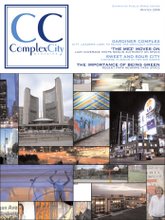Bridging Toronto's Gardiner complex
 BY SEAN PEARCE
BY SEAN PEARCE
The fate of Toronto’s venerable Gardiner Expressway has been the subject of many debates in city council over the last few years. Bold proposals have been presented as to what to do with Toronto’s grey concrete freeway and the engineer behind one of these proposals says that Toronto is finally ready to take the risk and decide.
Jose Gutierrez is a civil engineer who is trying to make his vision, the Toronto Waterfront Viaduct, a reality. The proposal calls for the Gardiner Expressway to be retro-fitted with a series of cables and an elevated sky-path that will feature a nice view, plant life and a pedestrian friendly walkway. Gutierrez hopes the Gardiner will therefore become less of a barrier to the waterfront and more of a gateway.
“Toronto used to be (cautious),” Gutierrez said. “Toronto in the new millennium is a lot more bold and ready for something more dramatic.”
Kristen Jenkins, communications representative for the Toronto Waterfront Revitalization Corporation (TWRC), says that transforming the way the Gardiner looks doesn’t change the fact that it remains a physical and psychological divider between the city and its waterfront. Jenkins says the TWRC’s preferred proposal, to take down the section between Spadina Avenue and the Don Valley Parkway, will remove that obstacle from the public psyche.
“This option… is a much more practical solution to addressing the barrier effect of the Gardiner,” Jenkins said. “We’ve got this opportunity to do something with the Gardiner because the waterfront is going to happen and it’s going to be great.”
Jenkins expressed doubts that Toronto City Council would choose to transform the Gardiner. She said the plan the TWRC is favouring will likely prove a less costly venture. Jenkins also said that whatever is done with the expressway money will be the deciding factor, as is always the case.
“Council can’t be asked to decide on something where there are no options for funding,” Jenkins said. “I don’t think (the numerous Gardiner proposals) have ever gotten past the urban design and engineering stage and that’s what is happening now, but the city is looking at potential financing options.”
Gutierrez says that money needn’t determine the matter because, if Toronto is willing to make a daring choice, money will come from private sources.
“I envision a lot of private investments in this project and I foresee a big chunk, more than 50 per cent, of the money will come from the private sector,” he said.
Gutierrez adds that the first step will not be funding, but getting the politicians to realize they need a freeway along the lakeshore.
“The councillors first need to realize that the waterfront needs and expressway,” Gutierrez said. “Putting traffic on the surface routes with street lights is just going to choke the whole area up.”
William Allen lives in Toronto’s east end and often walks his dog along Lake Shore Boulevard East where the pillars of the Gardiner Expressway’s demolished eastern section still stand. He says the city should keep the freeway and that its uglier features can be transformed.
“If it’s safe to leave it up and it’s working the way it is why change it?” Allen said. “It is a little dirty underneath… but that can be brightened up in areas for pedestrians to cross under it.”
Allen also says that despite the demise of the Gardiner’s eastern section, he still feels separated from the waterfront because of the wide roadway and the noise.
“I don’t like crossing a huge, wide expanse of roads,” he said.
Allen said he likes the concept of the Toronto Waterfront Viaduct and doesn’t mind having the old Gardiner there, as long as an effort is made to beautify the Gardiner. In his opinion, improving the Gardiner doesn’t need to be a difficult or costly venture.
“(The Gardiner) needs lots of green space; it doesn’t have to be fancy green space, just lots of nice trees,” Allen said.





No comments:
Post a Comment